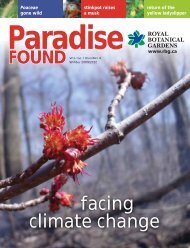Download a PDF of the updated Checklist of - Royal Botanical ...
Download a PDF of the updated Checklist of - Royal Botanical ...
Download a PDF of the updated Checklist of - Royal Botanical ...
You also want an ePaper? Increase the reach of your titles
YUMPU automatically turns print PDFs into web optimized ePapers that Google loves.
In 1947, Ivy Jean Brown and Raymond A. Sims collected terrestrial vascular<br />
plants, concentrating primarily on <strong>the</strong> uplands surrounding Cootes Paradise,<br />
but also collecting in <strong>the</strong> Hendrie Valley and Rock Chapel Sanctuaries. An<br />
unpublished list <strong>of</strong> species was compiled (Brown and Sims, 1947). This<br />
survey was continued in 1948 with <strong>the</strong> collection <strong>of</strong> aquatic species by<br />
Peter Pase, who also compiled a manuscript list (Pase, 1948).<br />
During <strong>the</strong> period 1954–1957, Aleksander Tamsalu <strong>of</strong> <strong>the</strong> Gardens’ staff<br />
conducted a floristic survey <strong>of</strong> all <strong>of</strong> <strong>the</strong> Gardens’ properties except <strong>the</strong><br />
Rock Chapel Sanctuary and <strong>the</strong> Valley Road Properties. His explorations<br />
greatly increased <strong>the</strong> number <strong>of</strong> vascular plant species known to occur on<br />
<strong>the</strong>se properties. Tamsalu’s specimens constitute <strong>the</strong> greater part <strong>of</strong> <strong>the</strong><br />
Gardens’ records <strong>of</strong> spontaneously occurring species. Hi<strong>the</strong>rto, however,<br />
<strong>the</strong> records <strong>of</strong> his floristic inventory have remained in <strong>the</strong> form <strong>of</strong><br />
herbarium specimens only, except for a manuscript report <strong>of</strong> his earlier<br />
ecological studies (Tamsalu, 1953; see also Lord, 1980).<br />
The vascular flora <strong>of</strong> <strong>the</strong> Rock Chapel Sanctuary was surveyed in 1963 by<br />
Robert M. Johns, who prepared an unpublished list <strong>of</strong> species collected<br />
(Johns, 1963). Since <strong>the</strong> Valley Road Properties (now called <strong>the</strong> Berry<br />
Conservation Area) were acquired by <strong>the</strong> Gardens in 1965, I have collected<br />
vascular plants from <strong>the</strong>se areas. McMaster University biology students and<br />
various o<strong>the</strong>r persons have from time to time collected additional plant<br />
specimens from <strong>the</strong> Gardens’ natural areas. Since becoming Taxonomist at<br />
<strong>Royal</strong> <strong>Botanical</strong> Gardens, I have checked for accuracy <strong>of</strong> identification each<br />
species and variety alleged by herbarium labels to have occurred on <strong>the</strong>se<br />
properties, and have examined nearly all <strong>of</strong> <strong>the</strong> individual specimens in <strong>the</strong><br />
Gardens’ herbarium which had been collected from <strong>the</strong>se natural areas.<br />
Brown and Sims’, Tamsalu’s, and Johns’ collections were accompanied by<br />
maps, on which <strong>the</strong> natural areas surveyed were divided into smaller units.<br />
In Tamsalu’s surveys, <strong>the</strong> Cootes’ Paradise and Hendrie Valley Sanctuaries<br />
were divided into 270 ecologically and physiographically defined areas;<br />
<strong>the</strong>se are sufficiently small that in many cases <strong>the</strong>y can be used for <strong>the</strong><br />
relocation <strong>of</strong> a wild plant population. Johns’ records, in which <strong>the</strong> Rock<br />
Chapel Sanctuary is divided into 18 such units, are likewise useful in<br />
locating plant species. (See also maps in Wragg (1949).)<br />
iii<br />
BOTANICAL EXPLORATIONS 1969–2002<br />
Dr. Pringle’s primary responsibilities at <strong>the</strong> Gardens have related to his<br />
systematic research. However, he continues to document additions to <strong>the</strong><br />
flora <strong>of</strong> <strong>the</strong> Gardens’ sanctuaries, particularly newly established exotic<br />
species (Pringle, 1973, 1974, 1980, 1986a, b, 1994, 2003).<br />
Several biologists were employed in surveying <strong>the</strong> wetland flora <strong>of</strong> Cootes<br />
Paradise in <strong>the</strong> 1970s. The first was John “Jack” Lord. The results <strong>of</strong> his work<br />
were included in later publications by Len Simser. Simser conducted both floral<br />
and zoological surveys in <strong>the</strong> sanctuaries (Simser, 1982; Painter, McCabe, and<br />
Simser, 1999). He later went on to lead efforts to restore <strong>the</strong>se wetland areas.<br />
Under his direction, Justus Benkhuysen conducted additional wetland flora<br />
surveys (Pomfret and Benkhuysen, 1993) and initiated a wetland planting<br />
program (see Restoration and Conservation Work). Jeremy Lundholm<br />
continued this work from 1996 to 1998 (Lundholm and Simser, 1999).<br />
My own research into <strong>the</strong> flora <strong>of</strong> <strong>the</strong> Gardens’ sanctuaries began in<br />
1998. My primary responsibilities have been to assist in <strong>the</strong> restoration <strong>of</strong><br />
Cootes Paradise. In addition, I have conducted extensive vegetation surveys<br />
over <strong>the</strong> entire property, with special attention paid to provincially and<br />
nationally rare species (Smith, 1999; Smith and Oldham, 1999; Smith,<br />
2000a, b; Smith, Lundholm, and Simser, 2001; Thuring and Smith, 2001;<br />
Smith, 2003). Paul O’Hara provided invaluable assistance with survey<br />
work in 2000 and 2001, particularly in documenting populations <strong>of</strong> <strong>the</strong><br />
endangered species, red mulberry (Morus rubra) and few-flowered club-rush<br />
(Trichophorum planifolium) (O’Hara, 2000a, b). I have also compiled detailed<br />
vegetation community maps, which are on file at <strong>the</strong> Gardens.<br />
As <strong>of</strong> 2001, Carl Rothfels has taken over as <strong>the</strong> Gardens’ field botanist.<br />
In his first season he made many significant contributions and corrections<br />
to this checklist (Rothfels, 2003). I have included all <strong>of</strong> his records up to<br />
January 2003.<br />
iv



